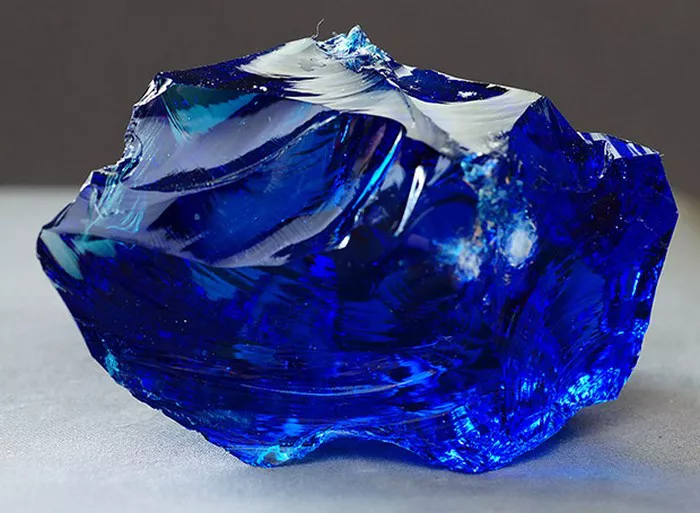Lab-grown sapphires, the epitome of modern gemstone innovation, are man-made marvels cultivated within the confines of a controlled laboratory environment. Contrary to their naturally occurring counterparts, which are formed deep within the Earth’s crust over millions of years, lab-grown sapphires are meticulously crafted through advanced scientific processes.
At the heart of this creation lies the Verneuil process, a pioneering technique developed by Auguste Verneuil in the late 19th century. This method involves the meticulous melting of aluminum oxide powder, commonly known as alumina or corundum, to produce a crystal structure chemically identical to natural sapphire. Through controlled crystallization and meticulous temperature regulation, lab technicians can nurture the growth of flawless sapphire gems, harnessing the precision of modern science to emulate the beauty of nature.
Chemical Composition and Properties:
One of the most remarkable aspects of lab-grown sapphires is their indistinguishable likeness to natural sapphires in terms of chemical, physical, and optical properties. Composed primarily of aluminum oxide, with trace elements such as iron, titanium, and chromium lending them their characteristic hues, lab-created sapphires boast the same crystalline structure and refractive index as their mined counterparts.
What sets lab-grown sapphires apart is not their composition, but rather their method of formation. By meticulously controlling the growth conditions in a laboratory setting, manufacturers can produce sapphires with consistent clarity, color, and size, free from the imperfections often found in natural stones. This level of precision ensures that each lab-grown sapphire exhibits the same brilliance and durability as its natural counterpart, establishing them as genuine gemstones rather than mere imitations.
Quality and Color:
Lab-grown sapphires are celebrated for their exceptional quality and stunning color variations, with blue sapphires being the most coveted among consumers. From the rich, velvety tones of royal blue to the ethereal allure of Kashmiri blue and the delicate hues of cornflower blue, lab-created sapphires offer a diverse spectrum of shades to suit every taste and occasion.
What truly sets lab-grown sapphires apart is their unparalleled clarity. Unlike natural sapphires, which often contain inclusions and imperfections, lab-grown specimens are typically free from such blemishes, resulting in gems of exceptional purity and brilliance. This flawless clarity enhances the gem’s overall appearance, allowing it to sparkle and shimmer with unparalleled luminosity.
Furthermore, the controlled growth process enables manufacturers to produce sapphires of uniform color and quality, ensuring consistency across all facets of the gemstone. Whether set in a dazzling engagement ring or adorning a sophisticated pendant, lab-grown sapphires exude elegance and sophistication, making them a popular choice for discerning jewelry enthusiasts.
Ethical and Sustainable Choice:
In an era marked by growing awareness of ethical and environmental concerns, the demand for ethically sourced and sustainable gems has never been higher. Lab-grown sapphires emerge as a shining beacon of sustainability, offering a guilt-free alternative to traditional mined stones.
Unlike their natural counterparts, which are often extracted through environmentally destructive mining practices, lab-grown sapphires are cultivated in a controlled laboratory environment using minimal resources and without the need for extensive land excavation. This not only minimizes the ecological footprint associated with gemstone production but also mitigates the social and ethical concerns inherent in traditional mining operations.
By choosing lab-grown sapphires, consumers can take a stand for sustainability and ethical consumption, knowing that their purchase supports responsible practices and reduces harm to the planet. With their eco-friendly credentials and ethical integrity, lab-grown sapphires represent the future of gemstone craftsmanship, where beauty and sustainability go hand in hand.
Famous Examples and Popularity:
The allure of blue sapphires has captivated generations of jewelry enthusiasts, with iconic pieces adorning the fingers of royalty and celebrities alike. Perhaps the most famous example is Princess Diana’s engagement ring, featuring a stunning oval-cut blue sapphire surrounded by a halo of diamonds. This timeless piece, now worn by Catherine, the Duchess of Cambridge, continues to inspire awe and admiration, cementing the blue sapphire’s status as a symbol of love and royalty.
In addition to their historical significance, blue sapphires are also experiencing a resurgence in popularity as a choice for engagement rings. With their vibrant color and undeniable elegance, lab-grown sapphires offer couples a unique and sustainable alternative to traditional diamond rings, allowing them to express their love while making a positive impact on the planet.
Furthermore, as the birthstone for September, blue sapphires hold special significance for those born in this month, making them a popular choice for birthday gifts and commemorative jewelry. Whether as a symbol of love, a statement of style, or a token of celebration, lab-grown sapphires continue to captivate hearts and minds around the world, proving that beauty and sustainability can coexist harmoniously in the realm of fine jewelry.
In conclusion, lab-grown sapphires represent a triumph of science and craftsmanship, offering a sustainable and ethically conscious alternative to traditional gemstones. With their flawless clarity, vibrant colors, and timeless elegance, these man-made marvels continue to dazzle and delight, inspiring a new generation of jewelry enthusiasts to embrace sustainability without compromising on style or quality. As we look to the future, it is clear that lab-grown sapphires will shine ever brighter, illuminating the path towards a more sustainable and socially responsible jewelry industry.


